Analyzing the Offseason Coaching Carousel in Women’s College Basketball: Part One
How many coaching changes have there been this offseason, and has athletic directors’ decision-making changed in light of the coronavirus?
Thanks for reading the Her Hoop Stats Newsletter. If you like our work, be sure to check out our stats site, our podcast, and our social media accounts on Twitter, Facebook, and Instagram. You can also buy Her Hoop Stats gear, such as laptop stickers, mugs, and shirts!
Haven’t subscribed to the Her Hoop Stats Newsletter yet?
On April 5, the women’s college basketball world turned its collective attention to Austin, Texas, where Texas athletics director Chris Del Conte announced the hiring of former Mississippi State head coach Vic Schaefer to replace Karen Aston.
Schaefer is the biggest name on the move this offseason, but many other coaches have also changed jobs in what has come to be known as the “coaching carousel”: athletic directors part ways with one coach and hire another, often creating an opening at another school in the process. Other high-profile changes this offseason include Niele Ivey replacing the retired Muffet McGraw at Notre Dame, Denise Dillon replacing the retired Harry Perretta at Villanova, and Nikki McCray-Penson filling Schaefer’s former role at Mississippi State.
While it is natural to have turnover every offseason, this offseason is unique in the history of the sport because of the coronavirus pandemic, which also ended the 2019-20 season prematurely. The pandemic is creating significant uncertainty about what the 2020-21 season will look like and threatening universities’ budgets, so it’s natural to ask how it is affecting athletic directors’ hiring and firing decisions and therefore altering the coaching carousel.
To answer that question, I collected data on every head coaching change in Division I in the 2019 and 2020 offseasons. I started with the lists of head coaching changes published by High Post Hoops (2019) and WBB Blog (2020) along with data from Her Hoop Stats and collected further information about outgoing and incoming coaches from team websites. This data set reflects all coaching changes through May 24, 2020.
This article will focus on the number and timing of coaching changes, while Part Two will look at how many women are getting opportunities to be head coaches. One disclaimer before we get into the results: these data show how different the 2020 offseason has been from 2019, but they do not necessarily indicate how different this offseason is from a “typical” offseason. Answering the latter question would require data from several additional offseasons.
Overall offseason movement
So far, there have been far fewer coaching changes this offseason than in 2019. Whereas 42 schools made a coaching change in 2019, just 29 have done so this offseason, a 31% decrease. Put another way, 12% of the 351 Division I women’s basketball programs made a coaching change in the 2019 offseason compared to just 8% this year.
The power conferences—which I am defining as the ACC, Big 12, Big East, Big Ten, Pac-12, and SEC—represent 21% of schools in Division I, but they were responsible for just 17% and 14% of coaching changes in 2019 and 2020, respectively.
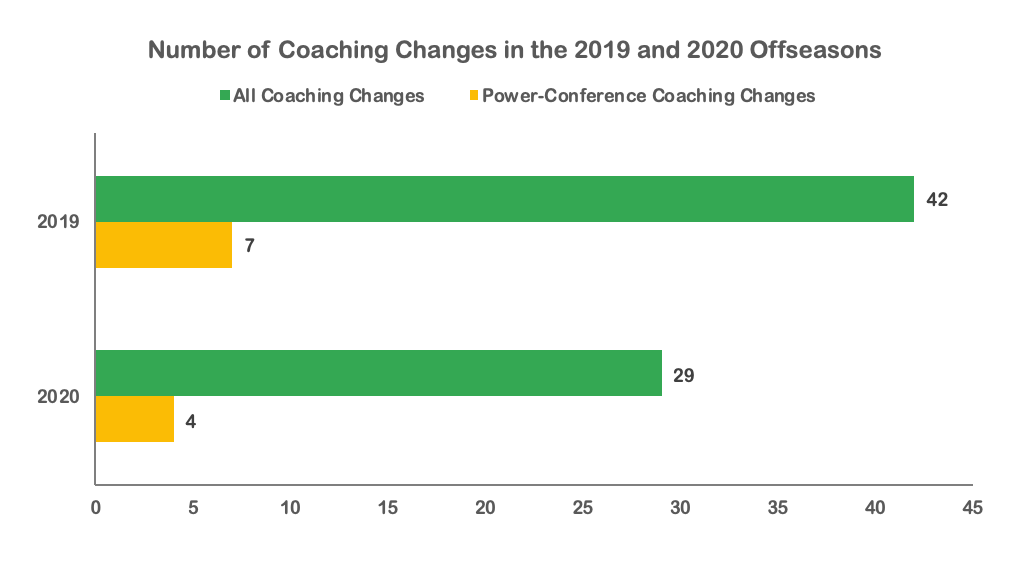
However, there could be more movement to come in 2020. March and April have been the most popular months for coaching changes in the last two offseasons, but schools and coaches can part ways at any time. Last year, there were four coaching changes between June and September, and six coaches were hired in June or later. In addition, there are still six vacancies out of the 29 jobs that have opened up this offseason, and if any of those schools hire a current head coach from another school, that would create another vacancy.
The reasons behind coaching changes
I categorized each coaching change based on the reason stated in the team’s official press release. Of course, the official reason does not always reflect the entire truth, but it still offers some insight into what precipitated the change.
I grouped all of the given reasons into four categories: coach’s decision, school’s decision, mutual decision, or no reason given. (The latter was mostly used in situations where an athletic department never officially announced that it was parting ways with a coach.) The breakdown of reasons looks relatively similar in the 2019 and 2020 offseasons:
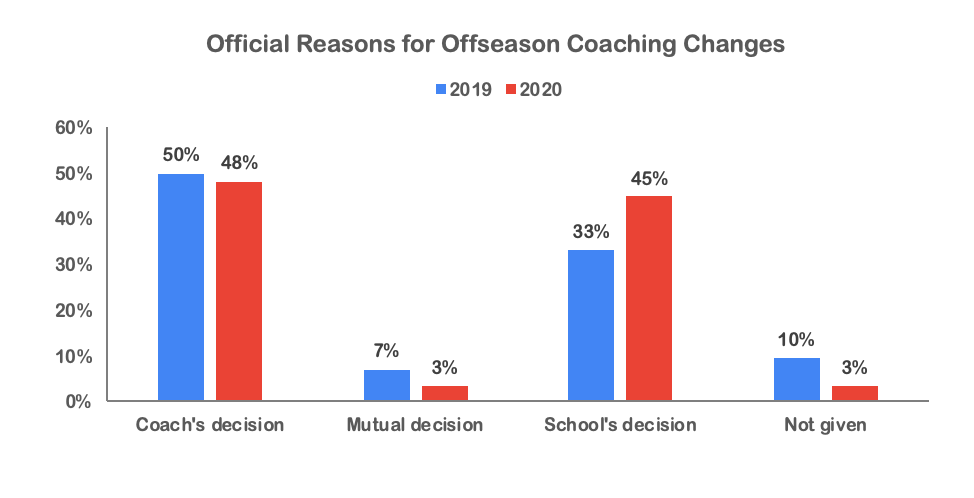
Coach’s decision was the most common category, representing about half of coaching changes in each offseason. This category included coaches retiring, resigning, or accepting another job. School’s decision, the second-most common category, included instances where a coach’s contract was not renewed, a coach was dismissed, or a coach who had been the interim head coach for the most recent full season was not given the job permanently.
Part Two of this series will examine gender equity in more detail, but notably, there were no gender differences observed in the reasons given for coaching changes. In fact, in 2019 and 2020 combined, 51% of cases in which a female coach left were her decision, compared to 46% of cases in which a male coach left.
In terms of hiring decisions, there is some evidence to suggest that athletic directors are valuing familiarity and shying away from risk more in 2020 than they did in 2019. First, 35% of new hires this offseason had prior playing or coaching experience at their new school, compared to 26% in 2019. Second, more coaches this offseason are being given the job on an interim basis for one year compared to in 2019. In at least one case, that was expressly due to the coronavirus: North Dakota athletics director Bill Chaves announced on March 30 that “In light of current events, I made the decision to cancel our women's basketball head coaching search and extend Coach [Mallory] Bernhard's interim appointment through the end of next basketball season. Once the season concludes, we will move forward with a search.”
The timing of the carousel
It seems possible that some athletic directors might slow down their head coaching searches, given how much uncertainty the coronavirus has brought. Schools or states may also have forced athletic directors to pause their searches by implementing hiring freezes or other restrictions. On the other hand, athletic directors hiring in the early part of the carousel may have anticipated a hiring freeze and accelerated their search to finish before it was implemented. And schools that are still able to hire might be disinclined to slow their process down if they think it could cause them to lose out on a candidate such as Schaefer, whom Texas hired just two days after declining to renew Aston’s contract.
The timing of this offseason’s carousel is tricky to pin down, as a lot will hinge on when the six schools with remaining vacancies hire a head coach. However, here is how the landscape looks at the end of May, presumably with the bulk of this offseason’s coaching changes behind us.
Overall, the decisions for coaches and schools to part ways are happening slightly later in 2020 than in 2019. The median date of those announcements was March 25 in 2019 and March 28 this year, and any additional announcements from schools would widen this difference.
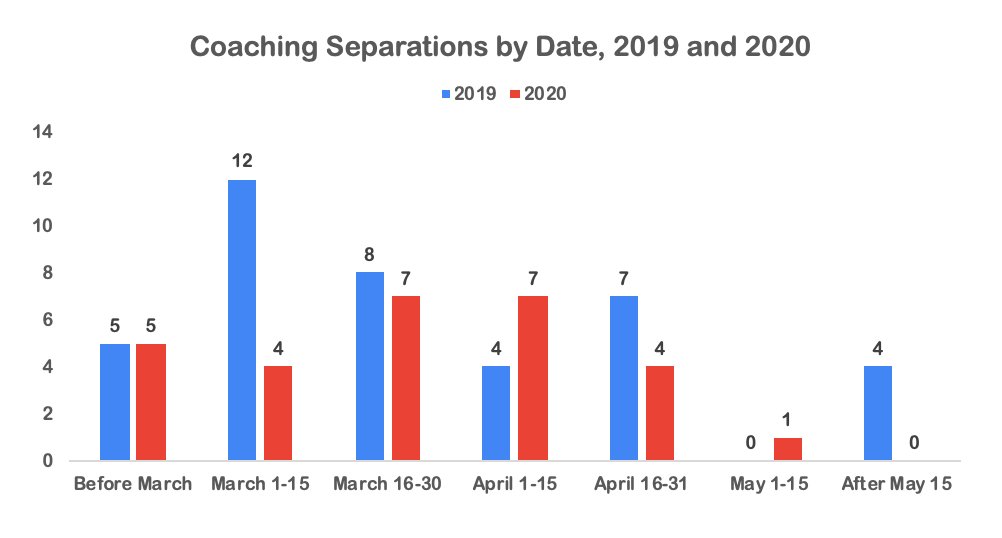
So far, coaches are being hired earlier in 2020 than in 2019, with the median dates of hire being 12 days apart. That does not account for the six vacancies, but adding those in, with any future projected date, still puts the median date of hire this offseason eight days ahead of 2019.
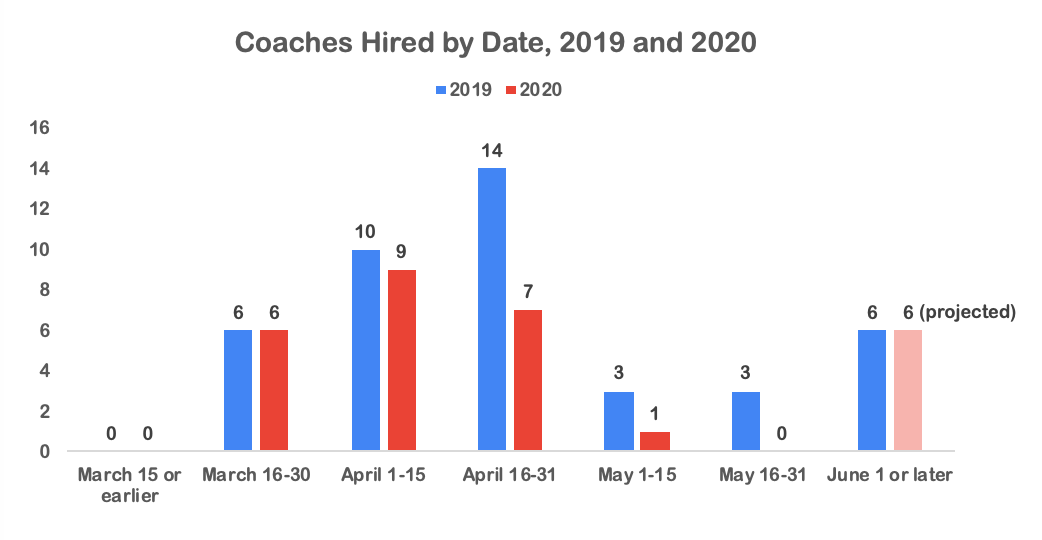
Similarly, the median length of time it takes a school to hire a new head coach has so far been 19 days, four days shorter than last season, but it will increase as the remaining vacancies are filled. If all six were to get filled on June 1, the median length of schools’ searches would be 26.5 days, and if all six were to get filled on July 1, the median length would be 29 days.
The decrease in the number of coaching changes combined with these small differences in timing have resulted in a remarkable change in the number of vacancies that exist on any given day:
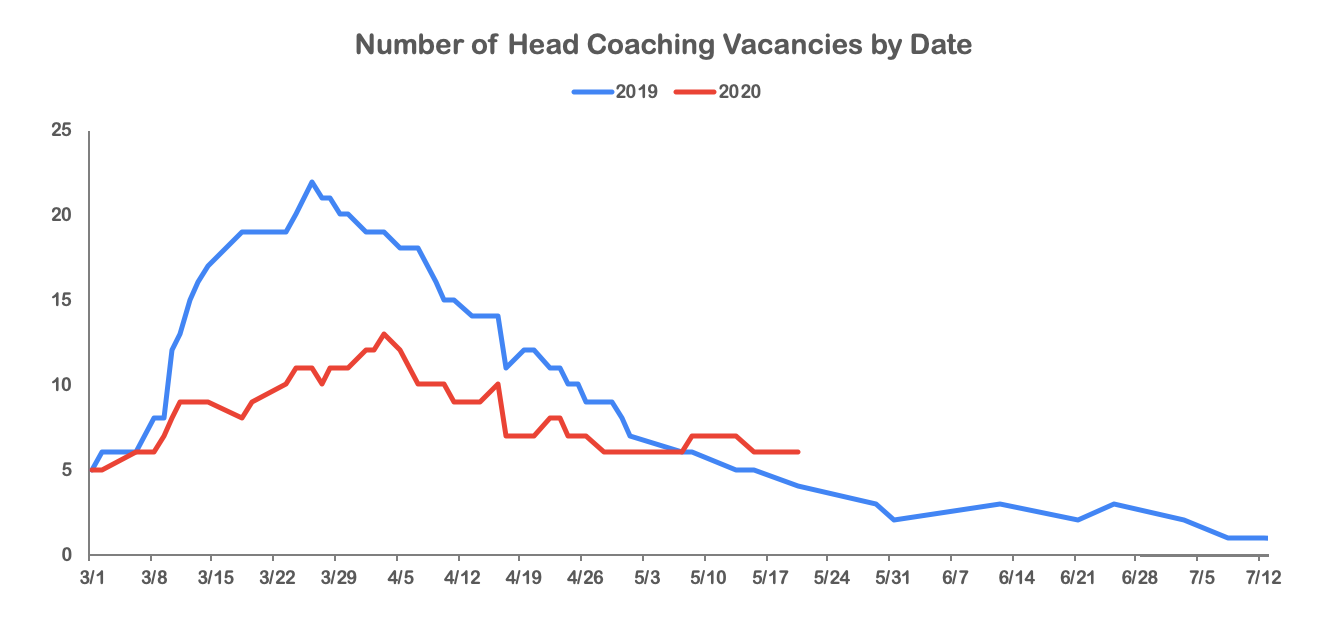
Note: Dates were conservatively estimated for the three cases across two offseasons where a school did not formally announce a coach’s departure.
Throughout March and April, there were far fewer vacancies in 2020 than in 2019. That flipped in May as more jobs were filled in 2019 than in 2020, and there are now more vacancies than there were at this time last year. As of June 1, 2019, nearly every job that had been announced had been filled, whereas one year later, 21% of this offseason’s jobs are still open.
Earlier this month, I asked a few new head coaches whether they believed the coronavirus pandemic had affected the number of job openings in women’s college basketball this offseason. None had a firm answer. “I don't have a feel for that one way or the other,” Schaefer said, “but it's certainly a very different and challenging time. There's no question about that.”
The data cannot fully answer that question, either, but they clearly show that there are some differences in the coaching carousel compared to a year ago, most notably in the smaller pool of openings this offseason. Part Two of this series will look more closely at who is being hired to fill these openings and specifically at whether women are getting equitable opportunities to become Division I head coaches in women’s college basketball.
Thanks for reading the Her Hoop Stats Newsletter. If you like our work, be sure to check out our stats site, our podcast, and our social media accounts on Twitter, Facebook, and Instagram.




It's content tho I'm not exactly sure what my takeaway is